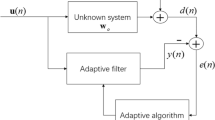Abstract
The performance of the least mean square (LMS) algorithm in sparse system identification has been improved by exploiting the sparsity property. This improvement is gained by adding an \(l_1\)-norm constraint to the cost function of the LMS algorithm. However, the LMS algorithm by itself performs poorly when the condition number is relatively high due to the step size of the LMS, and the \(l_1\)-norm LMS is an approximate method which, in turn, may not provide optimum performance. In this paper, we propose a sparse variable step-size LMS algorithm employing the \(p\)-norm constraint. This constraint imposes a zero attraction of the filter coefficients according to the relative value of each filter coefficient among all the entries which in turn leads to an improved performance when the system is sparse. The convergence analysis of the proposed algorithm is presented and stability condition is derived. Different experiments have been done to investigate the performance of the proposed algorithm. Simulation results show that the proposed algorithm outperforms different \(l_1\)-norm- and \(p\)-norm-based sparse algorithms in a system identification setting.





Similar content being viewed by others
References
Jin, J., Qing, Q., Yuantao, G.: Robust zero-point attraction LMS algorithm on near sparse system identificatio. IET Signal Process. 7(3), 210–218 (2013)
Gay, S.L., Douglas, S.C.: Normalized natural gradient adaptive filtering for sparse and non-sparse systems. In: IEEE International Conference on Acoustic, Speech and Signal Processing (ICASSP2002), pp. 1405–1408. Orlando, Florida (March 2002)
Widrow, B., Stearn, S.D.: Adaptive Signal Processing. Printice Hall, New Jersey (1985)
Wu, F.Y., Tong, F.: Non-uniform norm constraint LMS algorithm for sparse system identification. IEEE Commun. Lett. 17(2), 385–388 (February 2013)
Chen, Y., Gu, Y., Hero, A.O.: Sparse LMS for system identification. IEEE International Conference on Acoustic, Speech and Signal Processing (ICASSP2009), pp. 3125–3128. Taipei, Taiwan (April 2009)
Khong, A.W.H., Xiang, L., Doroslovacki, M., Naylor, P.A.: Frequency domain selective tap adaptive algorithm for sparse system identification. In: IEEE International Conference on Acoustic, Speech and Signal Processing (ICASSP2008), pp. 229–232. Las Vegas, Nevada, (March 2008)
Gui, G., Peng, W., Adachi, F.: Improved adaptive sparse channel estimation based on the least mean square algorithm. In IEEE Wireless Communications and Networking Conference (WCNC), pp. 3130–3134. Shanghai, China, (April 7–10 2013)
Gui, G., Adachi, F.: Improved adaptive sparse channel estimation using least mean square algorithm. EURASIP J. Wirel. Commun. Netw. 204(1), 1–18 (2013)
Kawamuri, S., Hatori, M.: A Tap Selection Algorithm for Adaptive Filters. In: IEEE International Conference on Acoustic, Speech and Signal Processing (ICASSP1986), pp. 2979–2982 (April 1986)
Homer, J., Mareels, I., Bitmead, R.R., Wahlberg, B., Gustafsson, A.: Improved LMS estimation via structural detection. In: Proceedings of IEEE International Symposium on Information Theory, Whistler, British Columbia (September 1995)
Etter, D.M.: Identification of sparse impulse response system using an adaptive delay filter. In: IEEE International Conference on Acoustic, Speech and Signal Processing (ICASSP1985), pp. 1169–1172 (April 1985)
Gay, S.L.: An efficient fast converging adaptive filter for network Echo cancellation. In: Presented at the thirty-second asilomar conference on signal, system and amplifier, , pp. 394–398. California, USA (November 1998)
Duttweiler, D.L.: Proportionate normalised least mean square adaptation in Echo cancelers. IEEE Trans. Speech Audio Process. 8(5), 508–518 (2000)
Gu, Y., Jin, J., Mei, S.: \(l_0\)-norm constraint LMS for sparse system identification. IEEE Signal Process. Lett. 16(9), 774–777 (2009)
Su, G., Jin, J., Gu, Y., Wang, J.: Performance analysis of \(l_0\)-norm constraint least mean square algorithm. IEEE Trans. Signal Process. 60(5), 2223–2235 (2012)
Harris, R.W., Chabries, D.M., Bishop, F.A.: A variable step (VS) adaptive filter algorithm. IEEE Trans. Acoust. Speech Signal Process. 34(2), 309–316 (April 1986)
Kwong, R.H., Johnson, E.W.: A variable step-size LMS algorithm. IEEE Trans. Signal Process. 40(7), 1633–1642 (July 1992)
Salman, M.S.: Sparse leaky-LMS algorithm for system identification and its convergence analysis. Int. J. Adapt. Control Signal Process. (August 2013). doi:10.1002/acs.2428
Salman, M.S., Jahromi, M.S.N., Hokanin, A., Kukrer, O.: A zero-attracting variable step-size LMS algorithm for sparse system identification. In: IX International Symposium on Telecommunications (BIHTEL2012), pp. 1–4. Bosnia and Herzegovina, October, Sarajevo (2012)
Kenney, J.F., Keeping, E.S.: Kurtosis. In Mathematics of statistics, Pt. 1, 3rd ed, pp. 102–103. Van Nostrand, Princeton, NJ (1962)
Haykin, S.: Adaptive Filter Theory. Prentice Hall, Upper Saddle River, NJ (2002)
Author information
Authors and Affiliations
Corresponding author
Rights and permissions
About this article
Cite this article
Aliyu, M.L., Alkassim, M.A. & Salman, M.S. A \(p\)-norm variable step-size LMS algorithm for sparse system identification. SIViP 9, 1559–1565 (2015). https://doi.org/10.1007/s11760-013-0610-7
Received:
Revised:
Accepted:
Published:
Issue Date:
DOI: https://doi.org/10.1007/s11760-013-0610-7




